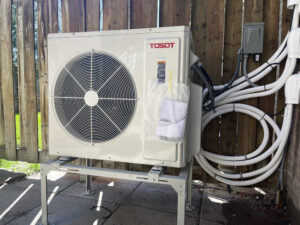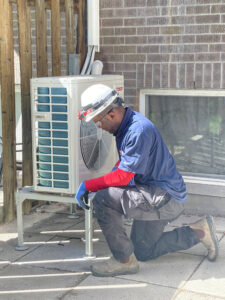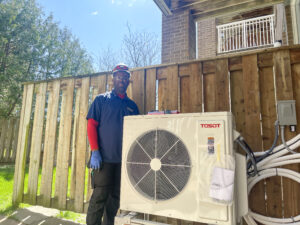Overcoming Limits: A New Path for Housing Electrification
Projects Sponsor
A social housing complex near Ottawa sought to replace inefficient baseboard heaters with heat pumps to cut energy use and improve tenant comfort. Early assessments revealed a major roadblock: the property’s electrical panels and utility service lacked the capacity to support the upgrades. Over two years of planning and research, the team collaborated with regulators to pioneer the use of load managers—devices that control electrical loads in real time to prevent overloading the electrical system. This innovation allowed the retrofits to proceed without costly panel upgrades or tenant disruption. The project achieved sustainable, affordable, cooler and cozier housing and sparked a regulatory change enabling electrification across Ontario.
 When a sixty-four-townhome complex near Ottawa—home to both market and subsidized units—decided it was past time to mend its energy ways, they brought in 1Click Heating & Cooling to retrofit the property with modern air-source heat pumps. The property was burdened with an outdated electric baseboard heating that was inefficient, costly to operate, and ineffective at maintaining consistent comfort for residents.
When a sixty-four-townhome complex near Ottawa—home to both market and subsidized units—decided it was past time to mend its energy ways, they brought in 1Click Heating & Cooling to retrofit the property with modern air-source heat pumps. The property was burdened with an outdated electric baseboard heating that was inefficient, costly to operate, and ineffective at maintaining consistent comfort for residents.
Switching to heatpumps, thereby lowering energy consumption and utility costs, cutting carbon emissions, and providing tenants with year-round comfort through both heating and cooling was the project goal. It was important work in itself, but ultimately these sixty-four townhomes would also be the launchpad for something much bigger.
The work 1Click did would contribute towards making a whole lot more residents comfortable than they could possibly have foreseen. The project became a replicable model that could be used to overcome one of the most significant barriers to electrification in older neighbourhoods.
Before undertaking this project, the stakeholders committed nearly two years to planning and research to fully understand the property’s existing conditions and constraints. This included a complete assessment of the site’s electrical and mechanical systems to determine what upgrades would be required to support the installation of air-source heat pumps.
 Detailed load calculations were carried out for each of the sixty-four units to evaluate whether the existing electrical panels could accommodate the additional demand. The results were conclusive: The property’s electrical infrastructure could not support the planned upgrades. The existing electrical panels lacked the capacity for additional load, and even if they’d been up to taking that burden, the incoming electrical service was simply not sufficient to provide it.
Detailed load calculations were carried out for each of the sixty-four units to evaluate whether the existing electrical panels could accommodate the additional demand. The results were conclusive: The property’s electrical infrastructure could not support the planned upgrades. The existing electrical panels lacked the capacity for additional load, and even if they’d been up to taking that burden, the incoming electrical service was simply not sufficient to provide it.
This revealed a broader systemic challenge. These were hardly the only sixty-four units in Ontario to have this issue. Many such older properties face similar infrastructure barriers that prevent the adoption of clean technologies. This project was asking a loaded question and 1Click was going to get it answered.
In an attempt to move forward, the 1Click team dutifully attempted to gather twelve months of electrical consumption data for each unit. Required by the Electrical Safety Authority, this data was meant to demonstrate maximum demand during both peak summer and winter periods, but that data was elusive.
Frequent tenant turnover meant obtaining reliable and complete data across all units proved nearly impossible. This challenge led 1Click to adapt their approach. They shifted their research efforts toward identifying alternative strategies that would allow the project to proceed despite the lack of available electrical capacity.
Necessity may be the mother of invention, but she’s also the boss of ending convention—and the innovation here was the change in the way electrical load is calculated. The issue of limited electrical capacity for the project was ultimately resolved through use of load management devices, a type of Energy Management System (EMS).
This approach eliminated a key barrier not only for this site, but for affordable housing and multi-family buildings across the province. The project’s success directly influenced a change in the Ontario Electrical Safety Code, which significantly broadened the approved use of EMSs.
 Under the new Rule 8-106 10), when equipment such as heat pumps or electric furnaces are controlled by an EMS, the demand load is considered only up to the maximum load the EMS allows—rather than the full connected load. Rule 8-106 11) further specifies that controlled loads do not need to be included in load calculations for service sizing, as long as the EMS monitors circuits and manages demand according to Rule 8-5008.
Under the new Rule 8-106 10), when equipment such as heat pumps or electric furnaces are controlled by an EMS, the demand load is considered only up to the maximum load the EMS allows—rather than the full connected load. Rule 8-106 11) further specifies that controlled loads do not need to be included in load calculations for service sizing, as long as the EMS monitors circuits and manages demand according to Rule 8-5008.
This regulatory change, driven by the demonstrated success of this project, removes one of the most significant technical and financial barriers to electrification. It unlocks retrofit opportunities for thousands of similar buildings across Ontario, validating the project not just as a one-off success, but as a scalable model for systemic impact.
In short, the project created a pathway for widespread replication, multiplying its environmental and social benefits far beyond the initial site where the benefits are already being felt.
 Tenants at the building enjoy more consistent heating in winter and for the first time, air conditioning in summer. Prior to the retrofit many units lacked any form of cooling and heating was often uneven—especially in spaces farther from the baseboard units. Meaningful communication with tenants was critical to the project. Through direct outreach and community events, residents were informed about the retrofit process, timeline, and the benefits they could expect—both in terms of comfort and cost savings.
Tenants at the building enjoy more consistent heating in winter and for the first time, air conditioning in summer. Prior to the retrofit many units lacked any form of cooling and heating was often uneven—especially in spaces farther from the baseboard units. Meaningful communication with tenants was critical to the project. Through direct outreach and community events, residents were informed about the retrofit process, timeline, and the benefits they could expect—both in terms of comfort and cost savings.
The methodical step-by-step approach undertaken by this project ensured a successful outcome while laying the foundation for scalable impact in the affordable housing sector.
It’s a hearth warming, heat pumping tale and one very likely to be repeated time and time again.













